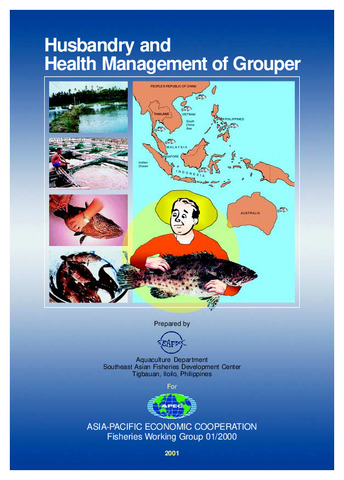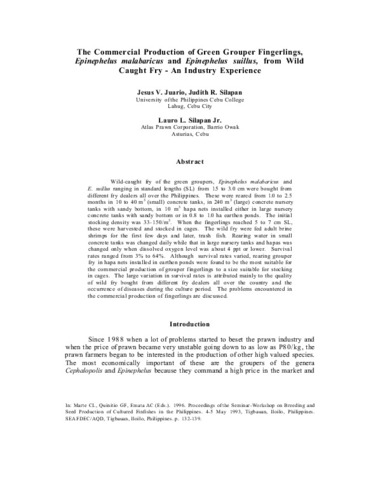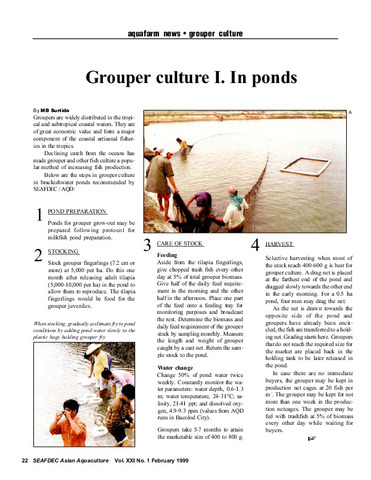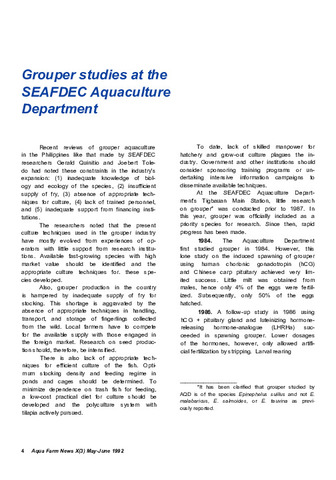Husbandry and health management of grouper
Share
អរូបី
The groupers (Family Serranidae) are among the most popular species in the live reef food fish industry in the Asia-Pacific region. Groupers are generally fast growing, hardy, suitable for intensive culture, and with excellent characteristics for processing. The high demand for these fishes is due to their unique culinary attributes and scarcity.
In 1997, the Asia-Pacific region contributed about 90% to the total world aquaculture production. The regional production of farmed grouper was estimated at 15,000 tons, with China as the biggest producer contributing 8,000 tons followed closely by Indonesia. Other countries in the region commonly produce 1,000-2,000 tons annually in 1990- 1997.
Groupers are generally cultured in floating net cages or earthen ponds, but cage culture is more common in Southeast Asia. Grouper pond production is becoming an attractive alternative to intensive shrimp culture in countries where management problems have forced growers to abandon shrimp farming.
Although grouper culture is widespread in Asia and the Pacific, its continued development is constrained by the limited availability of fingerlings. Most economies, with the recent exception of Chinese Taipei, rely almost totally on wild-caught fry and fingerlings for stocking. This demand for wild seeds has led to unsustainable and illegal collection practices such as the use of cyanide to capture large numbers of seed with relatively less investment in time and effort.
The inadequate supply of seed is further aggravated by the lack of appropriate handling techniques during collection, transport and storage of collected fish, and sometimes by an unregulated management of the wild stocks. There is also the lack of appropriate techniques for efficient grouper culture to marketable sizes. A major production constraint is heavy mortality of groupers during the collection and culture phases due to handling stress and diseases.
The utilization of non-destructive devices for grouper collection, proper fish handling and increased efficiency in culture management can result to socio-economic and environmental benefits. A well-developed grouper culture operation complemented by appropriate wild grouper fishery management can provide sustainable employment to many people – from marginal fishers to farmers to traders. Grouper fisheries based on illegal or destructive fishing practices underlines the urgent need for habitat protection and sustainable utilization of natural resources.
The objective of this manual is to provide a farmer-friendly practical guide for grouper farmers in the Asia-Pacific economies. It is hoped that this manual will enhance farmers’ ability to culture and handle grouper, as well as to prevent and manage disease outbreaks.
Suggested Citation
Asia-Pacific Economic Cooperation, & Southeast Asian Fisheries Development Center. (2001). Husbandry and health management of grouper. Singapore: Asia-Pacific Economic Cooperation and Tigbauan, Iloilo, Philippines: Aquaculture Department, Southeast Asian Fisheries Development Center.
ប្រធានបទ
បណ្តុំបណ្តុំ
Related items
Showing items related by title, author, creator and subject.
-
The commercial production of green grouper fingerlings, Epinephelus suillus, from wild caught fry - an industry experience
Juario, Jesus V.; Silapan, Judith R.; Silapan Jr., Lauro L. (Aquaculture Department, Southeast Asian Fisheries Development Center, 1996)Wild-caught fry of the green groupers, Epinephelus malabaricus and E. suillus ranging in standard lengths (SL) from 1.5 to 3.0 cm were bought from different fry dealers all over the Philippines. These were reared from 1.0 ... -
Grouper culture
Surtida, Marilyn B. (Aquaculture Department, Southeast Asian Fisheries Development Center, 1999) -
Grouper studies at the SEAFDEC Aquaculture Department
Castaños, Milagros T.; Southeast Asian Fisheries Development Center, Aquaculture Department (Aquaculture Department, Southeast Asian Fisheries Development Center, 1992)




